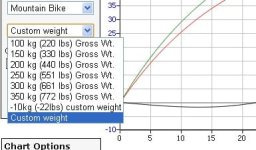rwright said:
psycholist said:
Welcome to the forum rwright. To simulate the addition of 100w of leg power, just click on the load line at the point where it would intersect 100w higher.
If I understand correctly, I manually move the cursor up in speed from the default load/power intersect and the difference between "Mtr Power" and "Load" is the power supplied by the legs. And the rest of the results, most importantly for me "range", are updated correctly. (Note: Acceleration is incorrect, but that's to be expected.)
That is correct. Everything in the stats would be correct except for the 'accelleration' value, which should be zero but will instead show the deceleration you would get if you stopped pedaling.
I still need to repeatedly move the cursor as I iterate the throttle until I reach the desired conditions, but that's still a lot easier than faking the aerodynamics.
We'll be modifying the simulator soon enough to simplify the process of getting these numbers. The plan at the moment to have two new fields, one for human power level, and a checkbox to select "auto adjust throttle".
If "auto adjust throttle" is selected, then as you move the cursor left and right to different speeds, the simulator will automatically find the right throttle point which results in the motor +human power curve crossing the load curve exactly at the cursor position. It will run a bit slower because the code will have to iteratively hone in on the right throttle value, but it will still be a lot faster than doing these adjustments manually!
-Justin
Thanks for the good suggestion psycholist.


